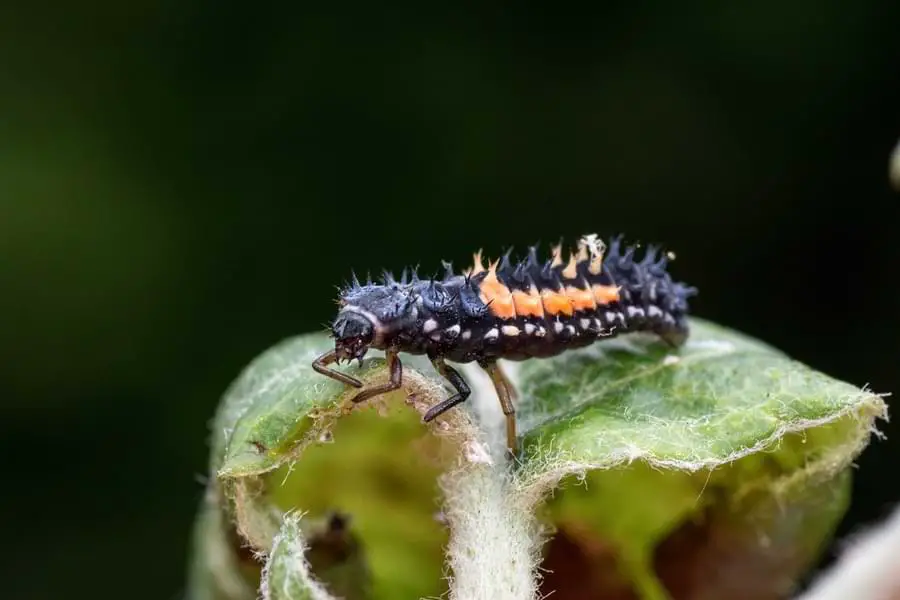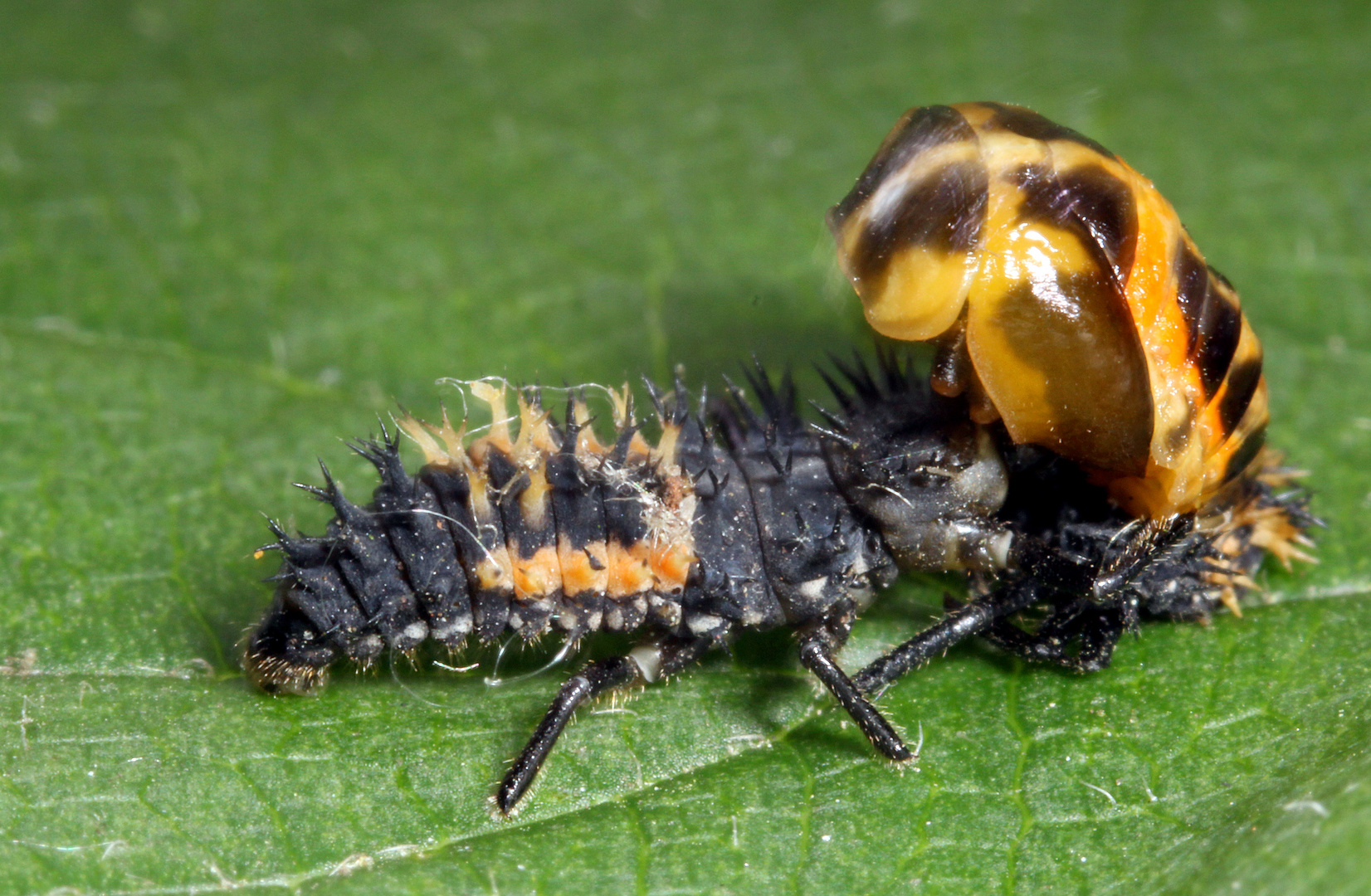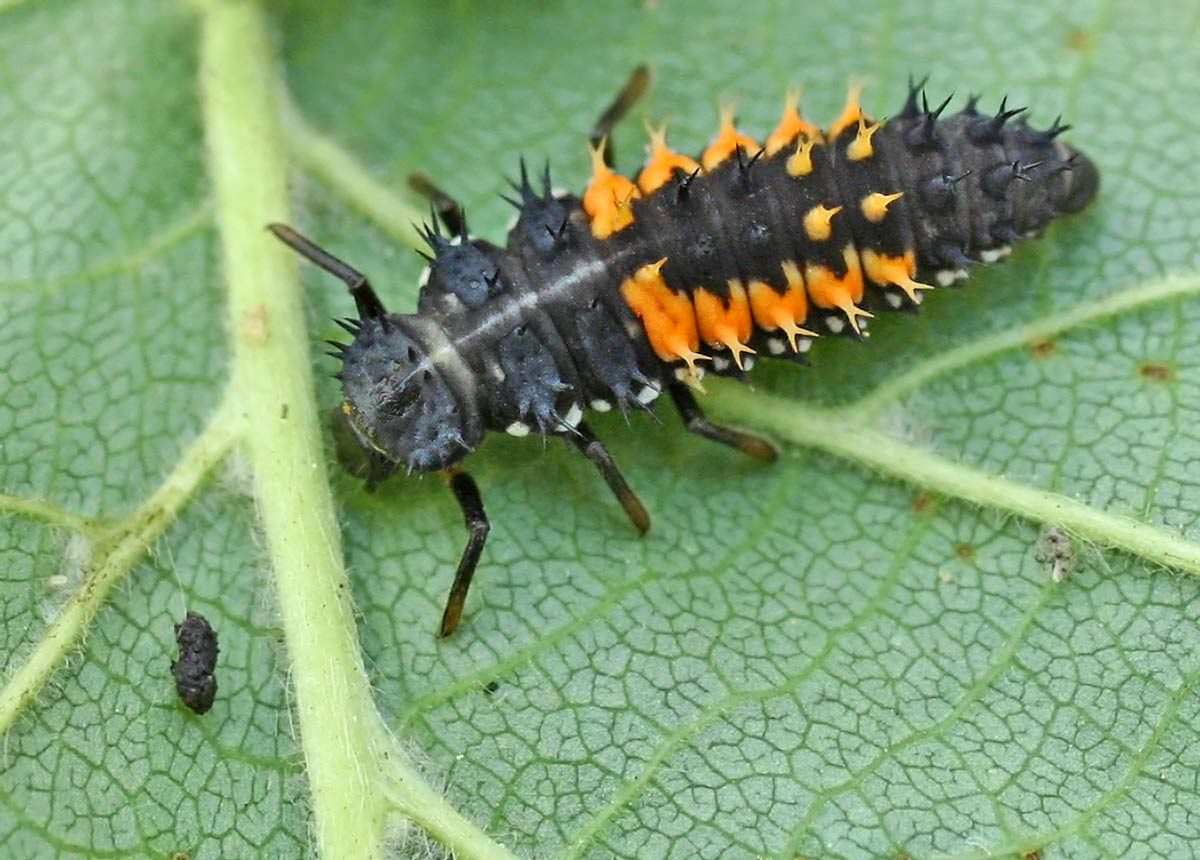
harmonia axyridis (Asian ladybug) larva Ladybug
Scientific name: Harmonia axyridis A non-native species originating from Asia, the harlequin ladybird is prevalent in towns and gardens. Species information Category Beetles Statistics Length: 8mm Conservation status Invasive, non-native species. When to see March to November About

Larve des Asiatischen Marienkäfers (Harmonia axyridis) beim Fressen einer MarienkäferPuppe
Convergent lady beetle larvae are active predators and begin searching for small insects soon after they hatch from the egg. In some cases, the unhatched eggs are eaten by the first larvae to emerge. Visual, olfactory, and chemical cues, including pheromones and honeydew secreted by aphids, may be used to locate prey.

Harmonia axyridis larva kenjonbro Flickr
The Asian lady beetle, or Harmonia axyridis, is a common ladybug that has been widely used in the U.S. to control the population and spread of other insects and plant pests, such as scale.

55 Awesome Harmonia Axyridis Larvae Insectpedia
Harlequin ladybird larvae (Harmonia axyridis) Ladybird larvae identifier: harlequin ladybird larvae (Harmonia axyridis) Harlequin ladybird larvae is black and spiny with strong orange, upside down L-shaped marks on each side and four small orange spots. It's found on all plants where aphids are present, but seems to prefer lime and sycamore.
photo4u.it il forum italiano della fotografia Larva di Harmonia axyridis
This lady beetle, or ladybug, is the Multicolored Asian Lady beetle, Harmonia axyridis, and it is driving people buggy throughout the state. During the fall, the beetle congregates on the sides of buildings, enters homes and lands on folks as they walk through their yards, and it sometimes bites. The multicolored Asian lady beetle can be easily.

Harmonia axyridis Larve de coccinelle Ladybird larva Flickr
Asian Lady Beetle (Harmonia axyridis) The Asia lady beetle alternately called the harlequin multicolored Asian beetle is a member of the family of ladybugs. It is easily recognizable from its red elytra and black spots, though the number of spots and exact coloration varies in each specimen.

harmonia axyridis larva Monica Iachelini Flickr
The larvae and adult H. axyridis produced a type II (hyperbolic) functional response curve across all temperatures and the three prey types they consumed.

Harlequin Ladybird Larva {Harmonia axyridis} Alex Hyde
H. axyridis is a promising biological control agent of several insect pests on a wide variety of ornamnental and agricultural crops.

Springfield Plateau Asian Lady Beetle Larvae
Harmonia axyridis is a cosmopolitan and non-specific polyphagous predator. It can survive ecologically diverse environments and exploit multiple preys. This study investigated the effects of.

Factsheet Harlequin ladybird Harmonia axyridis
Species Harmonia axyridis - Asian Lady Beetle Classification · Other Common Names · Explanation of Names · Numbers · Size · Identification · Range · Habitat · Season · Food · Life Cycle · Remarks · See Also · Print References · Internet References · Works Cited Classification Kingdom Animalia (Animals) Phylum Arthropoda (Arthropods)

Harlequin Ladybird Larva {Harmonia axyridis} Alex Hyde
Harmonia axyridis is a typical coccinellid beetle in shape and structure, being domed and having a "smooth" transition between its elytra (wing coverings), pronotum, and head. It ranges from 5.5-8.5mm in size. The common color form, f. "succinea", is orange or red in colouration with 0-22 black spots of variable size.

LARVA DE JOANINHA (Harmonia Axyridis) a photo on Flickriver
Abstract The multicolored Asian lady beetle, Harmonia axyridis (Pallas) (Coleoptera: Coccinellidae), is an important natural enemy in agricultural ecosystems. In spite of being a carnivore consuming protein-rich preys, the lady beetles often consume carbohydrate-rich food like nectar or honeydew.

Multicolored Asian Lady Beetle larva Harmonia axyridis, … Flickr
The Asian Lady Beetle, Harmonia axyridis. Larvae complete their development on plants where their primary food (aphids) is abundant. The non-mobile cocoon (pupal) stage remains attached to vegetation by its molted skin, but occasionally may be found clinging to exterior walls of buildings. The average time from egg to adult is about one.

Harmonia axyridis larva Entomology Today
The multicolored Asian lady beetle Harmonia axyridis Pallas was introduced from Asia both purposefully for classical biological control of arthropod pests and accidently into the United States many times during the twentieth century.

55 Awesome Harmonia Axyridis Larvae Insectpedia
However, most studies on nutrition regulation of carnivores mainly focus on protein and lipid, two major macronutrients in preys. In this study, nutrition regulation of protein and carbohydrate has been investigated in the 4th instar larvae of H. axyridis using Geometric Framework. We provided the insects two pairs of foods, one a protein.

Ladybird Larvae Harmonia axyridis succinea The harlequin… Flickr
Harmonia axyridis 4th instar larva had more microbial OTUs (4 9 6) and a higher percentage (52.6 %) of unique ones in the gut when being fed with conspecific eggs only at hatching (referred to as "CM-4th host"), as compared with the larva (356 OTUs, 40.2 % unique) fed with conspecific eggs across all larval stages ("CM-S4th") and the control (340 OTUs with 36.5 % unique ones, CM-CK4th.